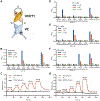Bispecific antibodies targeting mutant RAS neoantigens
- PMID: 33649101
- PMCID: PMC8141259
- DOI: 10.1126/sciimmunol.abd5515
Bispecific antibodies targeting mutant RAS neoantigens
Abstract
Mutations in the RAS oncogenes occur in multiple cancers, and ways to target these mutations has been the subject of intense research for decades. Most of these efforts are focused on conventional small-molecule drugs rather than antibody-based therapies because the RAS proteins are intracellular. Peptides derived from recurrent RAS mutations, G12V and Q61H/L/R, are presented on cancer cells in the context of two common human leukocyte antigen (HLA) alleles, HLA-A3 and HLA-A1, respectively. Using phage display, we isolated single-chain variable fragments (scFvs) specific for each of these mutant peptide-HLA complexes. The scFvs did not recognize the peptides derived from the wild-type form of RAS proteins or other related peptides. We then sought to develop an immunotherapeutic agent that was capable of killing cells presenting very low levels of these RAS-derived peptide-HLA complexes. Among many variations of bispecific antibodies tested, one particular format, the single-chain diabody (scDb), exhibited superior reactivity to cells expressing low levels of neoantigens. We converted the scFvs to this scDb format and demonstrated that they were capable of inducing T cell activation and killing of target cancer cells expressing endogenous levels of the mutant RAS proteins and cognate HLA alleles. CRISPR-mediated alterations of the HLA and RAS genes provided strong genetic evidence for the specificity of the scDbs. Thus, this approach could be applied to other common oncogenic mutations that are difficult to target by conventional means, allowing for more specific anticancer therapeutics.
Copyright © 2021 The Authors, some rights reserved; exclusive licensee American Association for the Advancement of Science. No claim to original U.S. Government Works.
Conflict of interest statement
Figures







Comment in
-
Bispecific antibodies catch cancer neoantigens.Nat Rev Drug Discov. 2021 May;20(5):342. doi: 10.1038/d41573-021-00062-2. Nat Rev Drug Discov. 2021. PMID: 33785902 No abstract available.
-
Bispecifics target cancers' most wanted.Nat Rev Cancer. 2021 May;21(5):279. doi: 10.1038/s41568-021-00354-0. Nat Rev Cancer. 2021. PMID: 33790461 No abstract available.
References
-
- Bedard PL, Hyman DM, Davids MS, Siu LL, Small molecules, big impact: 20 years of targeted therapy in oncology. Lancet 395, 1078–1088 (2020). - PubMed
-
- Canon J, Rex K, Saiki AY, Mohr C, Cooke K, Bagal D, Gaida K, Holt T, Knutson CG, Koppada N, Lanman BA, Werner J, Rapaport AS, Miguel TS, Ortiz R, Osgood T, Sun JR, Zhu X, McCarter JD, Volak LP, Houk BE, Fakih MG, O’Neil BH, Price TJ, Falchook GS, Desai J, Kuo J, Govindan R, Hong DS, Ouyang W, Henary H, Arvedson T, Cee VJ, Lipford JR, The clinical KRAS(G12C) inhibitor AMG 510 drives anti-tumour immunity. Nature 575, 217–223 (2019). - PubMed
Publication types
MeSH terms
Substances
Grants and funding
LinkOut - more resources
Full Text Sources
Other Literature Sources
Molecular Biology Databases
Research Materials

